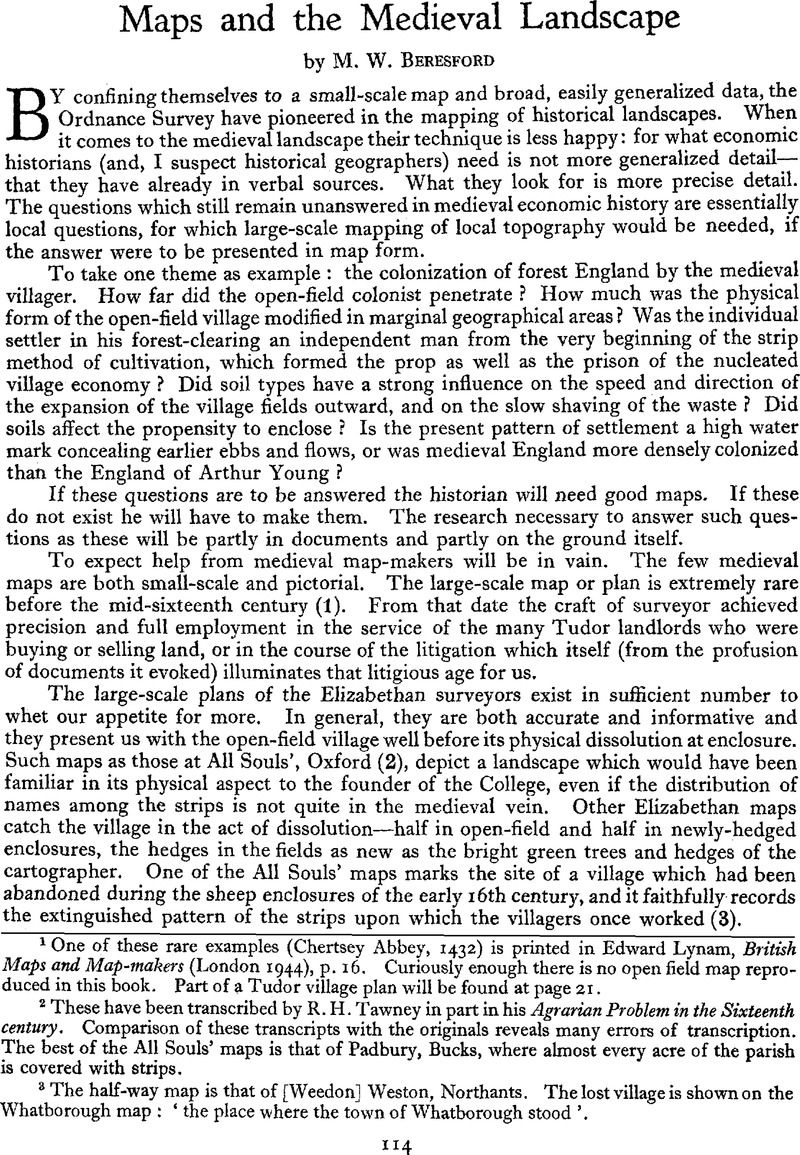Article contents
Maps and the Medieval Landscape
Published online by Cambridge University Press: 02 January 2015
Abstract

- Type
- Research Article
- Information
- Copyright
- Copyright © Antiquity Publications Ltd 1950
References
1 One of these rare examples (Chertsey Abbey, 1432) is printed in Edward Lynam, British Maps and Map-makers (London 1944), p. 16. Curiously enough there is no open field map reproduced in this book. Part of a Tudor village plan will be found at page 21.
2 These have been transcribed by R. H. Tawney in part in his Agrarian Problem in the Sixteenth century. Comparison of these transcripts with the originals reveals many errors of transcription. The best of the All Souls’ maps is that of Padbury, Bucks, where almost every acre of the parish is covered with strips.
3 The half-way map is that of [Weedon] Weston, Northants. The lost village is shown on the Whatborough map : ‘the place where the town of Whatborough stood’.
4 The Beds, maps are at the County Record Office. The Essex Record Office has published The Art of the Map Maker in Essex 1566-1860 (Chelmsford, 1947). There is no complete printed list of extant open-field maps. In the pre-war List of Cadastral Maps the Ordnance Survey indicated those which it had photographed. Negatives and prints were bombed, but prints of many are in the British Museum map-room. In 1888 R. B. Mowat printed Sixteen Old Maps of Oxfordshire.
5 ‘Ridge and Furrow and the Open Fields’ in Economic History Review (new series) 1, 34 (1948). Open field maps are here printed side by side with air photographs of the same area showing ridge and furrow. See also Plates 28-9 of Wessex from the Air where Mr O. G. S. Crawford made a similar comparison for Calstone, Wilts.
6 I have described and transcribed the Leicestershire terriers in W. G. Hoskins (ed.) Studies in Leics. Agrarian History (Leicester, 1949), pp. 77-126. The Yorkshire terriers are dealt with in Yorks. Archaeological Journal, 1950.
7 I am describing this and other Warwickshire sites in the Birmingham and Midland Archaeological Society’s Transactions, vol. 66 (in the press).
8 The air photograph references of these two sites are : Wharram Percy, CPE UK 2593/3030 ; Cestersover, CPE UK 1925/2005 and 4003. I have given short accounts, with photographs of both the Ridge and Furrow and the Lost village themes in two articles in ‘Country Life’—‘What is Ridge and Furrow’ (4 March 1949) (Plates of 1593 map of Weston, Northants; air photographs of that area and of East Newton, E.R. Yorks. ; ground photographs of Ilmington, Warws. ; map of 1737 of Allestree, Derbys.). ‘Tracing Lost Villages’ ibid, 15 October 1948). (Plates of 1586 map of Whatborough, Leics., with air photograph of the site; air photographs of Cottam, E.R. Yorks.; Upper Radbourn, Warws.; Cestersover, Warws.). Two other air photographs of field-patterns will be found in the article cited above in the Yorks. Arch. Journal, 1950 (of Wighill, W.R., and of Hornby, N.R.)
9 Lincoln Record Society, volume 19 (1924) The Lincolnshire Domesday. O. G. S. Crawford in Antiquaries Journal, 1925, p. 432, for photograph of Gaisthorpe. The Berks, site is described in Oxoniensis V, p.31 (1940) by Bruce Mitford. Dr Hoskins’ article is in Trans. Leics. Archaeological Society, XXII, 242.
10 Smaller scale maps could be used for the recording of manorial boundaries, distribution of monastic property, manor houses, castles, mills, etc. I believe that Colonel Drew is compiling such a tenurial topography.
- 2
- Cited by




